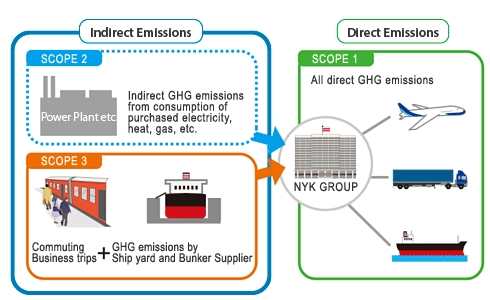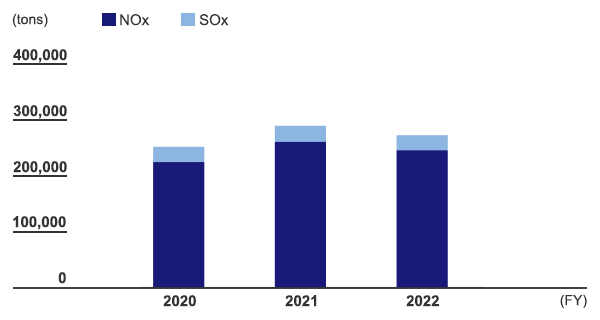Environmental Performance Data
Disclosing GHG data based on the GHG Protocol
NYK regularly receives an assurance statement from a third-party certifier confirming that NYK is reporting and disclosing accurate numerical values for greenhouse gas (GHG) emissions by NYK Group companies. This data is then used in calculations to confirm that NYK is meeting the framework of Scope 1, 2, and 3 of the GHG Protocol*1, a benchmark that NYK has achieved since 2012.
Scope1, 2 & 3 for NYK Group

- More Information:
The NYK Group's GHG Emissions by Scope
| GHG-related Units: ton-CO2e | ||||
|---|---|---|---|---|
| Overall output | FY2021 | FY2022 | FY2023 | Ratio in FY2023 (%) |
| Scope1 | 12,678,695 | 11,255,044 | 11,410,363 | 76.4 |
| Scope2 | 45,391 | 76,255 | 63,342 | 0.4 |
| Scope1+2 | 12,724,086 | 11,331,299 | 11,473,705 | - |
| Scope3 | 3,890,661 | 3,264,023 | 3,455,848 | 23.1 |
| Scope1+2+3 | 16,614,748 | 14,595,322 | 14,929,553 | - |
| Emissions from Biofuel (from ships) | - | - | 15,230 | - |
Note 1: The scope of aggregation includes headquarters and consolidated subsidiaries.
Note 2: CO2e: CO2 equivalent
Note 3: GHG emission data for Scope 1, Scope 2, Scope 3 and baio fuel has been verified by a third-party organization.
Verification Report (https://www.nyk.com/english/esg/envi/data/)

| Output breakdown | Sub category | FY2021 | FY2022 | FY2023 |
|---|---|---|---|---|
| Scope1 | Ships | 10,708,996 | 10,123,951 | 10,224,932 |
| Aircraft | 1,721,397 | 964,063 | 1,048,651 | |
| Others | 248,301 | 167,029 | 136,779 | |
| Total | 12,678,695 | 11,255,044 | 11,410,363 | |
| Scope2 - market basis | 45,391 | 76,255 | 63,342 | |
| Scope2 - location basis | 49,010 | 77,710 | 67,375 | |
| Scope3 | Category 1 | 1,887,367 | 1,486,233 | 1,347,827 |
| Category 2 | 255,143 | 197,887 | 482,457 | |
| Category 3 | 1,730,934 | 1,552,422 | 1,585,711 | |
| Category 5 | 16,379 | 19,827 | 29,792 | |
| Category 6 | 678 | 7,404 | 9,877 | |
| Category 7 | 157 | 247 | 183 | |
| Total | 3,890,661 | 3,264,023 | 3,455,848 | |
| Emissions from Biofuel (from ships) | Ships | - | - | 15,230 |
Note 1: Scope 2 emissions are calculated on a market basis inside Japan and on a location basis overseas.
The NYK Group's NOx and SOx Emissions
| Other than GHGs | |||
|---|---|---|---|
| Output (from ships) | FY2021 | FY2022 | FY2023 |
| NOx | 243,726 | 229,722 | 238,244 |
| SOx | 26,970 | 25,216 | 24,994 |

The NYK Group's Consumption Amount
| GHG related | |||||
|---|---|---|---|---|---|
| Input breakdown | Sub category | Unit | FY2021 | FY2022 | FY2023 |
| Scope1 | Heavy oil A | Tons | 30,415 | 27,219 | 143,986 |
| Heavy oil C | Tons | 3,184,649 | 2,979,644 | 2,972,183 | |
| Gas oil (ships) | Tons | 159,484 | 173,779 | 69,341 | |
| LNG (ships) | Tons | 5,620 | 14,387 | 41,530 | |
| Jet fuel | KL | 699,024 | 391,486 | 423,584 | |
| Gasoline | KL | 71,860 | 9,058 | 3,602 | |
| Kerosene | KL | 52 | 49 | 32 | |
| Diesel | KL | 23,285 | 49,408 | 41,418 | |
| LPG | Tons | 511 | 375 | 2,547 | |
| Natural Gas | m3 | 8,624,448 | 7,460,194 | 7,834,651 | |
| Private power generation derived from renewable energies | MWh | - | 5,970 | 8,874 | |
| Scope2-related | Electricity | MWh | 119,880 | 162,030 | 146,029 |
| Electricity derived from renewable energy | MWh | - | - | 15,722 | |
| Scope3-related | Waste (office) | Tons | 5,679 | 6,831 | 10,142 |
| Biofuel | Ships | Tons | - | - | 6,287 |
Note 1: Electricity consumption in Japan is calculated on a market basis. CO2 emissions volume from electric power consumption for each fiscal year has been calculated using the coefficients for each electricity provider (actual figures for each fiscal year) published by Japan's Ministry of the Environment.
| Other than GHGs | ||||
|---|---|---|---|---|
| Input from offices | FY2021 | FY2022 | FY2023 | |
| Water | m3 | 292,510 | 863,697 | 339,188 |
| Paper | KG | 636,903 | 1,007,991 | 1,021,337 |
Obtaining Environmental Load Data from Domestic and Overseas Group Companies
Grasping the environmental burdens of energy consumption is the first step toward reducing GHG emissions. We collect data on environmental burdens such as electricity usage, fuel consumption, industrial waste, and so on from domestic and overseas consolidated subsidiaries companies in an effort to comprehensively grasp the load situation throughout all our group companies and promote further reductions at the individual company level.
Domestic
To better visualize our global environmental performance, we started collecting GHG Emissions data in January 2007 from major domestic consolidated group companies. As of March 2024, we were collecting data on 35 items from 196.
Overseas
In January 2008, we started collecting GHG Emissions data.
As of March 2024, we were collecting data on the same 35 items from 342 locations as in the domestic network. This network serves as a communication tool with each company, in addition to allowing us to visualize the collected data.
We will continue to work toward more effective GHG emission reduction through ongoing analysis.

